Four EV charging modes in IEC 61851 standard
The charging system provides energy supply for the operation of electric vehicles and is an important basic support system for electric vehicles. It is also an important link in the commercialization and industrialization process of electric vehicles. With the rapid development of the electric vehicle industry, charging technology has become one of the key factors restricting the development of the industry, and intelligent and fast charging methods have become the trend of electric vehicle charging technology development.
There are different methods for classifying electric vehicle charging devices. Overall, it can be divided into on-board charging devices and off board charging devices. According to the different ways of energy exchange when charging electric vehicle batteries, charging devices can be divided into contact and induction types. Electric vehicles are divided into slow charging, fast charging, battery swapping, wireless charging, mobile charging, and other charging methods according to different charging methods. In this article, we will introduce different charging modes for electric vehicles designated by the International Electrotechnical Commission (IEC).
International standards are being developed to meet the demands of the electric vehicle market. The global popularity of electric vehicles depends on
well-established international standards that can address safety, reliability, and interoperability issues in the electric vehicle market.
In this article, we will investigate different charging modes for electric vehicles designated by the International Electrotechnical Commission (IEC). These modes are specified in the IEC 61851 standard for handling conductive charging systems for electric vehicles. This standard describes four different charging modes - Mode 1, Mode 2, Mode 3, and Mode 4.
IEC has also established standards for other electric vehicle charging technologies. For example, IEC 62196 discusses plugs, sockets, vehicle connectors, and vehicle entrances, while IEC 61980 discusses wireless power transmission (WPT) systems for electric vehicles.
Different types of cable connections
IEC 61851-1 describes three different connection methods, as shown in the following figure:
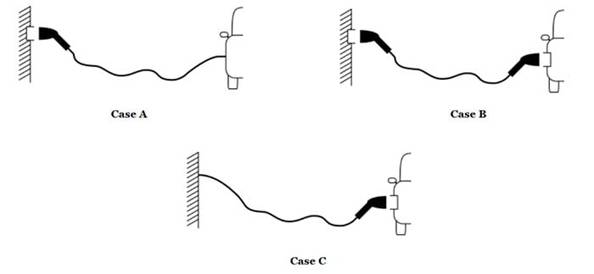
Case A: The cable is permanently connected to the electric vehicle, but the EVSE is detachable at the charging station (also known as EVSE - electric vehicle supply equipment). Case B specifies cables that can be separated at both ends, while Case C is a cable permanently connected to EVSE.
Charging mode 1
In this mode, the electric vehicle is directly connected to a household socket. The maximum current of this mode is 16A, with single-phase not exceeding 250V and three-phase not exceeding 480V.
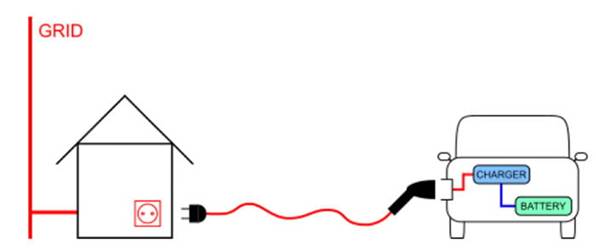
Mode 1 is a simple charging mode that does not support any communication between the EV and the charging point. This charging method is prohibited or restricted in many countries.
EV charging mode 2
Household sockets do not always provide electricity according to actual standards. In addition, sockets and plugs designed specifically for home applications may not be able to withstand sustained current consumption at rated values.
That's why connecting electric vehicles to sockets without control and safety functions for a long time increases the risk of electric shock. To address this issue, we have developed charging mode 2, which uses a special type of charging cable equipped with an in cable control and protection device (IC-CPD).
IC-CPD performs the necessary control and safety functions. This mode has a current of 32A and a voltage not exceeding single-phase 250V or three-phase 480V. Mode 2 can be used for household and industrial sockets.
The safety function of this mode can detect and monitor the protective grounding connection. Overcurrent and over temperature protection are two additional safety features supported by Mode 2. In addition, EVSE can perform function switching when detecting connections with EVs and analyzing their charging power requirements.
Charging mode 2 and its accompanying cables are shown in the following figure.
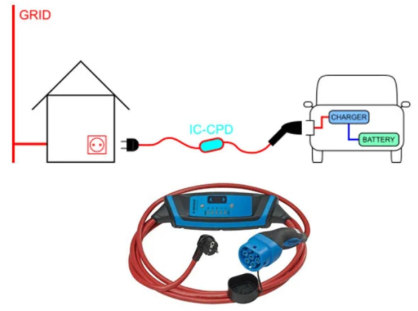
Although Mode 2 can be used for private charging, its public use is limited in many countries/regions.
EV charging mode 3
This mode uses a dedicated EVSE and EV car charger. The alternating current from the charging station is applied to the onboard circuit to charge the battery. Adopting multiple control and protection functions to ensure public safety. This includes verifying the protective grounding connection and the connection between EVSE and EV.
In addition, this mode can adjust the charging current to the current capacity of the cable components. This charging mode has a current of 250 A and uses a 250 V single-phase or 480 V three-phase network. It also supports a working mode compatible with Mode 2, where the current limit for single-phase and three-phase situations is below 32 A.
Any of the three possible connections (Scenario A, Scenario B, and Scenario C) can be used in this mode. B and C are shown below.

Let's take a look at how this mode defines communication between charging stations and EVs. The control pilot circuit of Mode 3 is shown in the following figure.
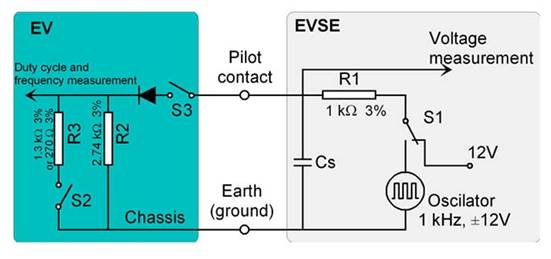
According to the status of switches S1, S2, and S3, different voltage levels will appear on the "pilot contact". This can be used as a representation of different charging stages. EVs can start their charging cycle as follows:
Before inserting the charging cable, disconnect switches S2 and S3, and connect S1 to a 12V DC power supply. In this case, the voltage measured by the EVSE at the guide contact is 12 V DC (the EVSE realizes that the EV is not yet connected).
After the charging cable is connected to both the EV and EVSE, the controller on the EV side can open S3 and reduce the voltage of the guide contact to around 9 V. This notifies the EVSE cable to be connected to both the EV and the EVSE. In addition, the DC 9 V signal on the pilot contact tells the EV that the EVSE is not yet ready.
When the EVSE is ready to charge the EV, it connects S1 to the oscillator. The PWM signal on the pilot contact tells the EV EVSE that it is ready.
Then, the EV opens S2 to generate a voltage of approximately 6V at the pilot contact to indicate that it is also ready. The voltage generated at this stage depends on the value of the R3 resistor. The value of this resistor specifies whether ventilation is required in the charging area. When R3=1.3 k Ω, the lead contact voltage is approximately 6 V. This corresponds to charging areas that do not require ventilation. For areas that require ventilation, use R3=270 Ω, which provides a lead contact voltage of approximately 3 V.
When the vehicle is charging or for any reason wants to terminate the charging cycle, it can turn off S2. This will change the positive voltage level of the PWM to 9 V and notify the EVSE that the EV is not yet ready for charging.
EV charging mode 4
This is a charging mode that combines an off board charger with DC output. The direct current is directly transmitted to the battery, and the car charger is bypassed. This mode can provide 600 V DC and a current of 400 A. The high power level involved in this mode requires more advanced communication and stricter security features.
Mode 4 only allows case C connection, where the charging cable is connected to the charging station.
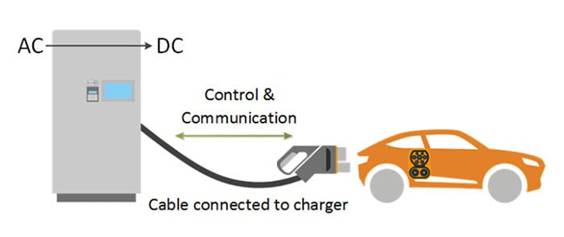
conclusion
The IEC 61851 standard relates to conductive charging systems for electric vehicles. This standard describes four different charging modes - Mode 1-4.
The first three modes provide AC current for EV car chargers; However, Mode 4 directly provides DC current to the battery and bypasses the car charger. Mode 3 adopts multiple control and protection functions with the goal of public safety. We have studied the control pilot circuit of this mode in more detail in this article.
